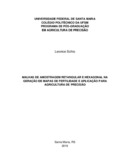| dc.creator | Schio, Leonice | |
| dc.date.accessioned | 2017-01-09 | |
| dc.date.available | 2017-01-09 | |
| dc.date.issued | 2016-09-15 | |
| dc.identifier.citation | SCHIO, Leonice. SAMPLING GRID RECTANGULAR AND HEXAGONAL GENERATION OF MAPS OF FERTILITY AND APLICATION FOR AGRICULTURE OF PRECISION. 2016. 78 f. Dissertação (Mestrado em Agronomia) - Universidade Federal de Santa Maria, Santa Maria, 2016. | por |
| dc.identifier.uri | http://repositorio.ufsm.br/handle/1/4837 | |
| dc.description.abstract | Sample grid s are essential when we want to represent the variation in chemical and physical properties of the soil, being essential to know its features. In this way, this study aimed to relate the efficiency and practicality of using soil sampling knits of rectangular and hexagonal type in a farm located countryside Ivorá- RS. In order to get features that help the researcher and producer in choosing the appropriate mesh to represent and diagnose their crops by means of fertility maps and application. The methodological procedures consisted of structuring the rectangular and hexagonal sampling knits of 1 ha in the CR Campeiro 7, without user interference in the point s distribution. Soil samples were collected in June 2015. So, after analysis of the spatial distribution of points in the area for each of the cases the fertility maps and application were structured. Among the main results, it is noted that both knits can represent similarly the trends that the soil presents nevertheless, the rectangular grid, due to a higher number of points, can represent the variability more expressively, but was found that when there is a change in the position and number of sampling points in a crop, the representations of the maps have differences, which at first, analyzing only the fertility maps, these differences seem small, but when structured a map of application, this difference becomes significant as it will result in greater or lesser purchase of inputs. It is emphasized that each mesh has characteristics that will inevitably vary from crop to crop, and a sampling grid should be, always, planned and adjusted according to each case, combining the knowledge of the producer and additional data available to define the same. | eng |
| dc.format | application/pdf | por |
| dc.language | por | por |
| dc.publisher | Universidade Federal de Santa Maria | por |
| dc.rights | Acesso Aberto | por |
| dc.subject | Amostragem de solo | por |
| dc.subject | Agricultura de precisão | por |
| dc.subject | Malha hexagonal | por |
| dc.subject | Malha retangular | por |
| dc.subject | Soil sampling | eng |
| dc.subject | Precision agriculture | eng |
| dc.subject | Hexagonal grid | eng |
| dc.subject | Rectangular grid | eng |
| dc.title | Malhas de amostragem retangular e hexagonal na geração de mapas de fertilidade e aplicação para agricultura de precisão | por |
| dc.title.alternative | Sampling grid rectangular and hexagonal generation of maps of fertility and aplication for agriculture of precision | eng |
| dc.type | Dissertação | por |
| dc.description.resumo | As malhas de amostragem são fundamentais quando desejamos representar a variação de atributos químicos e físicos do solo, sendo imprescindível conhecer suas características. Desta forma, este trabalho teve como objetivo relacionar a eficiência e a praticidade da utilização das malhas de amostragem de solo do tipo retangular e hexagonal, em uma lavoura localizada no município de Ivorá- RS. Com o propósito de buscar características que auxiliem o pesquisador e o produtor na escolha da malha adequada para representar e diagnosticar suas lavouras, através de mapas de fertilidade e de aplicação. Os procedimentos metodológicos consistiram em estruturar as malhas de amostragem retangular e hexagonal de 1 ha no Sistema CR Campeiro 7, sem a interferência do usuário na distribuição dos pontos. As respectivas coletas de solo ocorreram no mês de junho de 2015. Assim, após a análise da distribuição espacial dos pontos na área para cada um dos casos e estruturados os mapas de fertilidade e aplicação. Entre os principais resultados encontrados, salienta-se que ambas as malhas conseguem representar de forma similar as tendências que o solo apresenta, no entanto, a malha retangular, por apresentar maior número de pontos, consegue representar a variabilidade de forma mais expressiva, mas nota-se que quando há uma alteração na posição e no número de pontos amostrais em uma lavoura, as representações dos mapas apresentam diferenças, que num primeiro momento, analisando somente os mapas de fertilidade, essas diferenças parecem ser pequenas, mas quando estruturado um mapa de aplicação, essa diferença passa a ser significativa, pois resultará em maior ou menor aquisição de insumos. Salienta-se que cada malha apresenta características que, inevitavelmente, variam de lavoura para lavoura, e uma malha de amostragem deve ser, sempre, planejada e ajustada conforme cada caso, aliando o conhecimento do produtor e dados adicionais disponíveis para definição da mesma. | por |
| dc.contributor.advisor1 | Cardoso, Claire Delfini Viana | |
| dc.contributor.advisor1Lattes | http://buscatextual.cnpq.br/buscatextual/visualizacv.do?id=K4770447U8 | por |
| dc.contributor.referee1 | Aita, Valmir | |
| dc.contributor.referee1Lattes | http://lattes.cnpq.br/9194460031371011 | por |
| dc.contributor.referee2 | Boemo, Daniel | |
| dc.contributor.referee2Lattes | http://buscatextual.cnpq.br/buscatextual/visualizacv.do?id=K4133713H6 | por |
| dc.creator.Lattes | http://lattes.cnpq.br/8123777702430522 | por |
| dc.publisher.country | BR | por |
| dc.publisher.department | Tecnologia em Agricultura de Precisão | por |
| dc.publisher.initials | UFSM | por |
| dc.publisher.program | Programa de Pós-Graduação em Agricultura de Precisão | por |
| dc.subject.cnpq | CNPQ::CIENCIAS AGRARIAS::AGRONOMIA | por |


